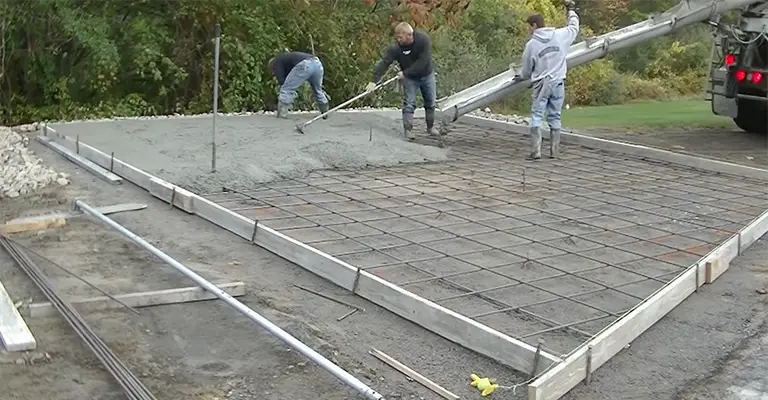Do you have to put metal bars (rebar) in a 4-inch-thick flat concrete surface? The need for rebar in a 4-inch concrete slab depends on the slab’s intended use and the project’s specific conditions.
Rebar, short for “reinforcing bar,” is often used in concrete structures to provide additional strength and prevent cracking.
When making a flat piece of concrete about 4 inches thick, like a sidewalk or a small platform, we might wonder if we need to include metal bars called rebar inside it.
Rebar helps make the concrete stronger and prevents it from breaking easily. It’s like giving the concrete some extra muscles. But whether we need to use rebar in a 4-inch slab depends on different things.
If the slab has heavy things on top of it, like big trucks or machines, rebar can strengthen the slab and hold up these heavy things without cracking or breaking.
Also, if the weather in that area changes a lot, like getting really cold or hot, rebar can help the concrete stay strong and not crack due to the changing temperatures.
Sometimes, the place where we want to build the concrete slab might have soil that moves or changes over time. Rebar can help the concrete stay in place and not shift or crack because of the moving ground.
Talking to people who know a lot about building things with concrete, like engineers or builders, is essential.
They can look at the specific things we want to do with the slab and the place where we want to put it. Then, they can tell us whether using rebar is a good idea.
Should You Reinforce A 4-Inch Slab?
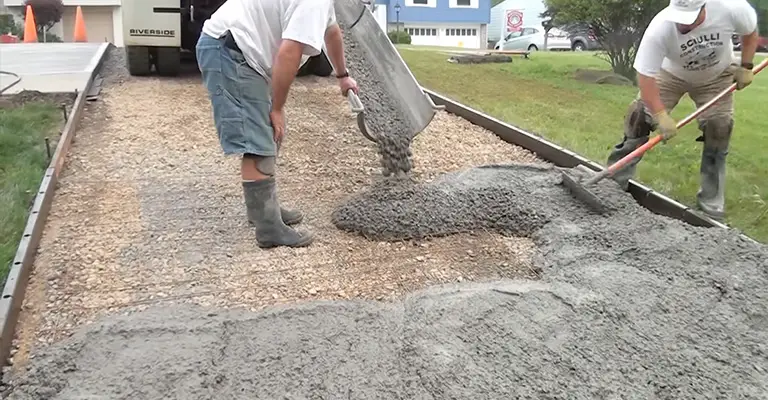
Do you need rebar when pouring a simple 4-inch concrete slab? There’s no need for rebar for a 4-inch concrete slab on grade.
A 4-inch slab cast on the ground will float without rebar in permanent contact with the ground. It’s recommended you use rebar on 5 – 6-inch-thick concrete.
You need a minimum of 1 1/2 inches of clear cover between the reinforcing and the top of a concrete slab.
You should have the same amount of clear cover on the underside of a suspended slab. There should be a minimum of 2 1/2 inches of clear space between the reinforcing and the slab bottom if the slab is on the ground.
The lower clear cover should be 3 inches whenever the ground is wet or damp. For that reason, reinforced concrete slabs are usually 6 inches thick.
For most situations, you can get away with welded wire fabric. You need rebar to reinforce suspended slabs almost always.
Code Requirements
You’ll need to consult the building codes if you want to build a slab that’s 4 inches thick. Many states follow the Uniform Building Code (UBC), which California uses. You might find different rules in other states.
You can consult a structural engineer if you need help with the design and construction. A slab with a 4-inch thickness needs reinforcement bars at the edges and in the middle.
Moreover, it needs a No. 3 bar extending in each direction within 16 inches. It meets the minimum UBC requirements but is not as durable and long-lasting as the design you want.
Reinforced Slab Foundation Durability
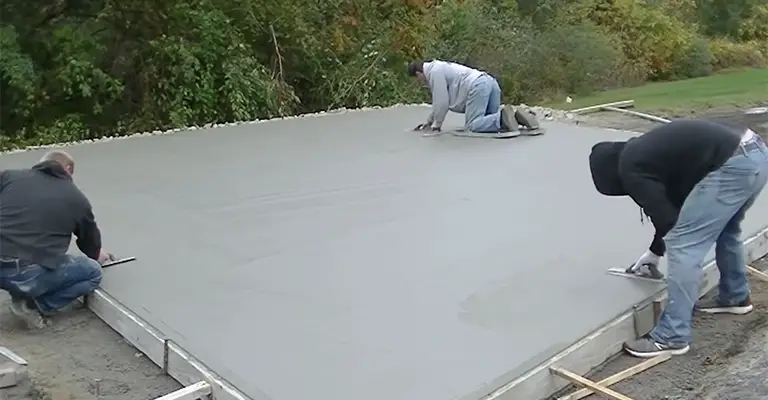
For a 4-inch slab, you’ll need a higher grade of rebar. If you’re making a slab 4 inches tall, use Grade 40 or Grade 50 rebar.
Generally, rebar is Grade 32 and utilized for 3-inch slabs. With rebar this thick, a four-inch slab will be more durable and last longer. The thicker the slab, the less likely it will crack from temperature changes and other factors like frost heave.
You’ll see the rebar sticking out of the concrete with thicker bars. Rebar can look good or bad to some people.
Your foundation will be more durable with thicker rebar, whether you like it or not. There is a difference in thickness between Grade 40 and Grade 50 rebar.
4-Inch Slab Loading Conditions
If the slab is four inches thick, it should be able to resist cracking and bending. Design drawings will help you build and reinforce your foundation with rebar to meet loading conditions.
Use a slab design analysis program to determine how much rebar you need for your 4-inch slab. A program will look at slab thickness, edge reinforcement, live and dead loads, and other things to calculate how much rebar you need.
Reinforcing Bar Size and Quantity Requirements
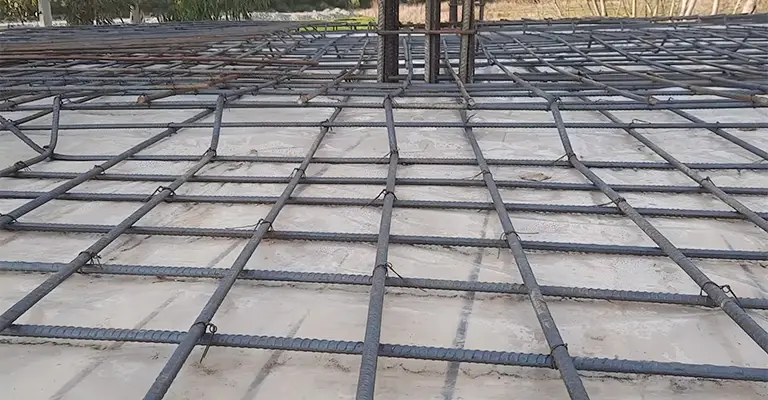
You need No. 3 bars at the edges and every 16 inches in the middle for slab reinforcement. That’s what you need for a 4-inch slab. Even though it’s sufficient for a 3-inch slab, it’s not for a 4-inch slab.
Concrete for a 4-inch slab must be thicker, so rebar must be more viscous. There’s a thicker No. 3 rebar designed for 4-inch slabs.
The minimum rebar size is No. 3. There are circumstances when smaller rebar can be used, but it’s not recommended.
The bars of No. 4 are the same diameter as bars of No. 3, but they’re only recommended for concrete with a 28-day compressive strength under 2,000 pounds.
Rebars To Be Installed In A 4-Inch Slab
You’ve got to install No. 3 rebar every 16 inches in the center and each edge of the slab to get 1.33 inches of rebar per foot. No. 3 bars must stay within 16 inches of the center in all directions.
Suppose your slab is 24 feet long. You’ll have to install four No. 3 bars at the edges and two at the center.
In addition to installing No. 3 bars wherever the slab meets columns or walls, you must install them at other load-bearing points.
You’ll need No. 3 bars for reinforcement at the edges and center of a 4-inch slab. Some circumstances allow you to use smaller bars. When slabs and diaphragms don’t go through a lot of tensile stress, No. 2 bars are good.
Rebar And Precast Or Cast-In-Place Concrete
Typically, reinforcing bar has ridges to help it stick to concrete better. Steel is the most common material, but other kinds are available too.
The reinforcement in concrete can either be prestressed or not. The former involves putting reinforcements, usually rebars, under strain or tension.
Afterwards, the concrete will dry, and this strain will be released, further compressing the concrete, which will help it use the tensile strength of the rebar.
In addition, precast and cast-in-place concrete slabs are both options. Usually, precast concrete is manufactured in a plant under exact dimensions and conditions.
The risk associated with cast-in-place is higher than with precast because it’s less precise.
You have a few options regarding the concrete mix, including mixing it yourself. You shouldn’t consider whether to install rebar, but they can be vital to the project.
What Thickness Must Concrete Be For Rebar?
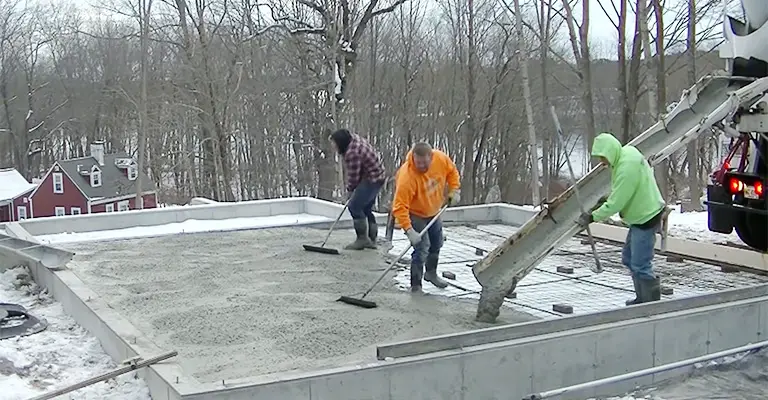
According to the American Concrete Institute (ACI), a couple of factors affect how thick the concrete must be to support rebar.
In general, precast concrete can handle the thinnest covering. There’s a reason for this: precast concrete made in a plant is much more precise. Correct casting of rebar is crucial to the reinforcement’s effectiveness.
The cast-in-place concrete needs to be placed around the rebar and held in place as it sets and dries. Usually, rebar supports help keep it at the proper depth, but these open it up to some operator error.
When permanently in contact with the ground, prestressed and non-prestressed cast-in-place concrete requires three inches of concrete over the rebar (source).
You can get away with about an inch if it’s not exposed to the weather or on the ground.
For precast reinforced concrete slabs with #11 bar and lower, ⅝ inches is the minimum cover required. Cast-in-place concrete slabs are around ¾ inches deep. Putting concrete in contact with the ground or exposed to the weather won’t work.
Three main things determine how thick the concrete must be to cover the rebar. The first thing to consider is the level of exposure to the elements.
In the case of contact with the ground or outdoors, the thickness of the concrete covering the reinforcement might need to be increased.
Also, the size of the rebar used affects the concrete thickness since thicker bars need more concrete.
#11 bar, for instance, has a diameter of 1.41 inches, while #14 has a diameter of 1.693 inches. This seemingly tiny difference is enough to need ⅝ inches and 1-¼ inches of thickness, respectively.
In addition, the concrete’s role affects the thickness of the cover. It takes less concrete over rebar on a slab or wall than on a column or beam.
You should use 3 inches of concrete for permanent cast-in-place concrete.
This means that, for cast-in-place slabs under 5 inches thick, there shouldn’t be any rebar in most cases. There’s just not enough thickness in these slabs to effectively protect and cover the reinforcing bar while still utilizing its benefits.
For optimal construction, check your local regulations, which consider the local environment.
Do You Need a Rebar For An 8-Inch Slab?
Trying to answer whether a slab with a particular dimension needs rebar shows a lack of understanding of concrete reinforcement design. The reason is here, hopefully, followed by a satisfactory answer.
In the type of concrete and for the purpose of the slab, concrete is reinforced to withstand structural loads.
We pour taxiways, roads, and equipment pads a foot thick or more using flexible concrete pavement. It’s just not needed with flexible concrete pavement.
The load requires us to pour 4-inch-thick slabs with #5 rebar on 8-inch centers in multistory buildings. So, the thickness of the slab has less to do with rebar requirements than the purpose and type of slab.
You can figure out if you need concrete reinforcement on the slab by asking these questions.
- Does it have conventional concrete load bearings?
- Does the subgrade look solid and compact?
- Is the concrete going to be exposed to cold and warm weather changes?
- How does it work? Is it suspended?
There are many questions to consider when deciding whether to reinforce a slab, which can only be answered by a qualified engineer.
The engineer will tell you whether you need reinforcement, what type, size, and spacing to use, and what kind of concrete to use.
Can You Pour Concrete Without Rebar?
Reinforcing bars provide concrete with more tensile strength, so it cracks less.
In situations where the slab isn’t supposed to bear heavy loads, concrete slabs poured on the ground don’t need rebar.
In addition to the pour size, the thickness determines if steel bar reinforcement is needed. Make sure you reinforce slabs 5 inches or thicker and larger pads.
Reinforcing steel should be used on slabs supporting structures, heavy machinery, or supplies.
It doesn’t have to be used for concrete slabs, but it improves its strength and lifespan. Steel is more durable and versatile than concrete, so some contractors won’t build slabs without it.
Adding rebar makes sense, as patios and driveways are being repurposed to support structures.
Final Words
Reinforcing concrete with rebar has a lot of benefits. However, you have to know when it’s necessary. Otherwise, you might weaken the slab.
You may not need rebar for 4 inches and below, especially if it touches the ground. In these cases, using welded wire mesh instead of rebar may be a better option. For more info, check out your local building regulations.

